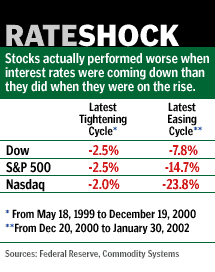
NEW YORK (CNN/MONEY) - Let the rate hike speculation begin!
Now that the Federal Reserve has changed its bias from "easing" to "neutral" (basically signaling that it's not as concerned about an economic slowdown anymore) investors will probably begin obsessing about when the Fed will start raising interest rates once again.
The market tends to take a simplistic view of interest rates. Lower interest rates=good. Higher interest rates=bad.
But it's more complicated than that. Even though the Fed is likely to raise interest rates at some point in the next few months, that does not mean investors should now steer clear of stocks.
Rates are still historically low
The Fed cut rates eleven times last year in an attempt to stimulate economic growth. While the economy did enter a recession last year, it appears that the slowdown is almost over. As a result, there are now fears that the Fed will have to keep raising rates in order to fight inflation.
But the federal funds rate now stands at 1.75 percent -- its lowest level in nearly forty years. Given this backdrop, even an eventual return to the pre-September 11 federal funds rate of 3.5 percent would not be crippling.

In fact, the Dow, S&P and Nasdaq actually performed better the last time the Fed was raising interest rates than they did last year when the Fed was cutting rates aggressively. (See chart to the right.)
The reason? Interest rate movements do not have an immediate impact on the economy -- or corporate profits. Last year was an abysmal one from an earnings standpoint. But most sectors that have been hit hardest in the recession (technology, finance and manufacturing, to name a few) are expected to post significant increases in earnings in the latter half of this year...several months after the Fed's last rate cut.
Earnings improving but keep an eye on valuation
To be sure, earnings estimates may be too high. But that will become a greater concern once the economic rebound is in full swing. For now, the fact that there should be growth is significant.
"Earnings do look as if they are about to start turning. In a rising rate environment, you at least have the earnings growth to sustain stock price movement," says Tobias Levkovich, senior institutional equity strategist for Salomon Smith Barney. "Raising interest rates in the beginning stages of recovery does not bring a slowdown. Raising rates in the latter stages of recovery is a different story."
| |
 More on the Fed and rates
More on the Fed and rates
| |
| | |
| | |
|
So what should investors consider now? Since the market hit its low point in September, sectors that have the most to gain from an economic rebound -- technology, financials and industrials come to mind -- have surged on the hopes of stronger profit growth. Their fundamentals will probably continue to improve but as a result, investors need to keep an eye on valuation.
For example, analysts are predicting strong earnings gains for most portions of the technology sector (telecom being the notable exception) but much of this enthusiasm is probably already priced into the stocks.
Ned Riley, chief investment strategist at State Street Global Advisors, says financials should perform well as the economy continues to improve as credit risk fears will start to wane. Valuation isn't as much of a concern for this sector either since these stocks aren't trading at big premiums to the market as tech is.
Industrials, which have already begun to benefit from signs of renewed buoyancy in the manufacturing sector, probably have a little more room to run as well. Riley says investors should not wait too long to buy since these stocks typically make most of their gains in the initial stages of a recovery. And the rally has already begun for this group. Minnesota Mining and Manufacturing, for example, is up 42 percent since September 21 and Caterpillar is up 36.2 percent.
Still, as long as companies deliver on their earnings promises, it doesn't make much sense to worry about interest rate hikes this year. "The risk of having a major sell off when the Fed starts tightening is relatively low," says Christoph Bianchet, chief U.S. economist for Credit Suisse Asset Management.

|

